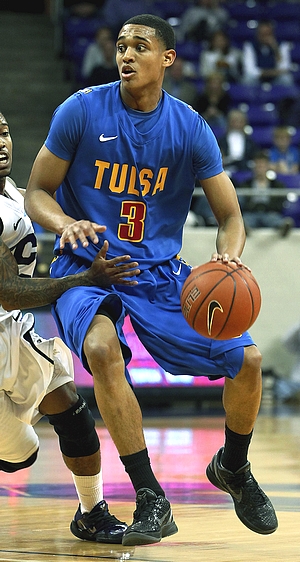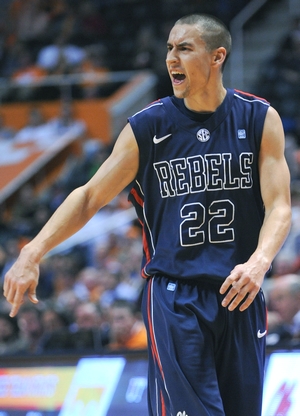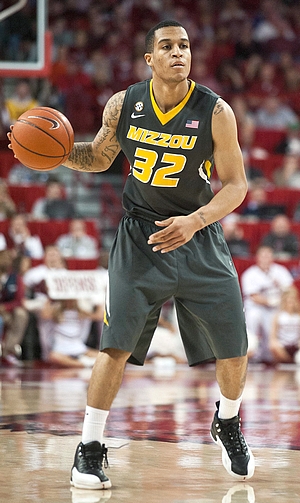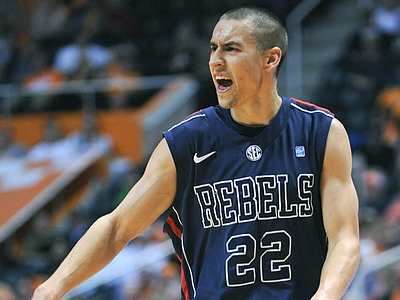Incoming freshmen have been excluded from these previews, as we'd like to wait and see what they have to offer on the NCAA level before we come to any long-term conclusions.
-Top 30 NBA Draft Prospects in the ACC
-Top 15 NBA Draft Prospects in the Big Ten
-Top 10 NBA Draft Prospects in the Big 12
-Top 15 NBA Draft Prospects in the Pac-12
-Top 15 NBA Draft Prospects in the Big East
-Top NBA Prospects in the SEC, Part One
(#1) Willie Cauley-Stein Scouting Video
-Top NBA Prospects in the SEC, Part Two
(#2) Patric Young Scouting Video
-Top NBA Prospects in the SEC, Part Three
(#3) Alex Poythress Scouting Video
-Top NBA Prospects in the SEC, Part Four
(#4) Jordan McRae Scouting Video
-Top NBA Prospects in the SEC, Part Five
(#5) Jarnell Stokes
(#6) Johnny O'Bryant
(#7) Trevor Releford
(#8) Dorian Finney-Smith
(#9) Will Yeguete
#10, Jordan Clarkson, 6-4, Shooting Guard, Junior, Tulsa

Joe Treutlein
Following a strong sophomore season at Tulsa in the 2011-2012 season, Jordan Clarkson sat out last year after transferring to Missouri. With three of the Tigers' top four scorers no longer with the team this season, Clarkson should have abundant opportunities to earn a significant role on the court, potentially even at the point guard position.
Standing 6'4 with a solid 6'7.5 wingspan and a decent frame, Clarkson is a good overall athlete, being pretty good with both his quickness and explosiveness, but not being a stand out in either area. He makes up for it somewhat by being a very heady and crafty player, getting the most out of his abilities off the dribble.
On the offensive end, Clarkson is a versatile inside-out threat who was relied on to create a lot of his own shots while at Tulsa, seeing most of his possessions come out of isolations or pick-and-rolls. He has great ability to get his defender off balance and create separation, having an excellent command of jab steps, ball fakes, crossovers, and rip moves, frequently using them to get himself open on the perimeter.
Clarkson relied on his jump shot slightly more than his ability to get to the basket, as he attempted shots off the dribble at a nearly 2:1 margin compared to catch-and-shoot jumpers at Tulsa. He's respectable pulling up for a shot in space, both from the mid-range and beyond the arc, but is a much better shooter with his feet set when he has the time to get off a shot comfortably. He has a minor hitch in his shooting motion, something that makes things a bit awkward on his pull-ups at times, but is no problem at all on his spot-up attempts.
Despite the fact that Clarkson saw so many of his shots coming of the off-the-dribble variety, he still shot 37.4% from behind the arc as a sophomore, a respectable number that could improve this year if he's allowed to play a more balanced role on what's likely to be a much more talented Missouri squad.
In terms of attacking the basket, Clarkson is a very skilled player who uses the tools at his disposal exceptionally well. He doesn't have the blazing first step to consistently get by his man, nor great size or leaping ability to shoot over players in the lane, but he has excellent touch around the basket both on lay-ups and runners, while he also takes good angles and shows good body control to get shot attempts off with defenders in the area.
The biggest problem for Clarkson's game projecting to the next level is how his dribble-drive game will translate, as despite his success at the college level, many of his shot attempts in these situations are made in very small windows over defenders, and even with all his strong traits, he's still just a decent finisher at this level as it is. Projecting this to the NBA where he'd be matched up against much larger and more athletic competition, it's questionable if he could succeed in the same way barring significant improvement physically or skill-wise.
On the defensive end, Clarkson shows a great fundamental base and effort level, frequently playing up on his man whenever he has the ball, but his lateral quickness is often exploited, especially when matched against smaller guards. To his credit, he does a great job recovering and staying with his man when he does give up a first step, and uses his length well to contest shots from the side and behind, but it's tough to see him not being at a disadvantage in quickness on this end of the floor at the next level.
Looking forward, Clarkson has a solid groundwork of skills with his very good shot-creating and shot-making abilities along with his inside-out offensive game, but his lack of standout physical attributes on both ends of the floor make the next level an uphill climb at this stage. Clarkson's best bet from an NBA perspective would likely be to further excel with his perimeter shooting game, which is the area least tied to his athleticism and most likely to easily translate in the pros, and he could have good opportunity to take a step forward there when he's playing what's likely a much less ball-dominant role for the Tigers.
#11, Marshall Henderson, 6'2, Senior, Shooting Guard, Mississippi

Derek Bodner
Marshall Henderson has taken a long and controversial path to his senior season, one which we still do not know exactly when it will start for the Mississippi guard, as he is currently suspended.
Henderson began his career at Utah all the way back in the 2009-10 season, but transferred to Texas Tech following his freshman season. After sitting out the 2010-11 season, Henderson would transfer to South Plains Junior College before playing a game for Texas Tech, deciding to leave after Texas Tech fired head coach Pat Knight. Henderson would lead South Plains to a 36-0 record and NJCAA national championship before transferring to Mississippi to begin his junior season.
Once there, Henderson had an outstanding year for the Rebels, scoring 20.1 points per game while leading Mississippi to its first SEC championship in over 30 years, with Henderson winning SEC tournament MVP honors. His offseason, however, started on a sour note, as Henderson was pulled over during a traffic stop by police in May and found to be in possession of small amounts of cocaine and marijuana, although he would officially only be charged with not having proof of insurance, earning Henderson an indefinite suspension from Ole Miss for conduct detrimental to the team. While Mississippi head coach Andy Kennedy is confident Henderson will be back at some point and will be trouble-free once he returns, as of this past week he has labeled the situation as fluid and was unsure of exactly when Henderson would be back in the lineup.
The incident last summer was not Henderson's first off the court transgression. Henderson was arrested back in 2009 while still in high school for trying to buy marijuana with counterfeit money, and then again in 2011 for misdemeanor possession of marijuana while still on probation, earning him time in jail. These recurring issues will certainly be something decision makers will have to think long and hard about when trying to determine his value at the next level, particularly considering his controversial on-court demeanor.
On the court, the 6'2" guard shows outstanding scoring instincts. He gets the vast majority of his offense from jump shots, nearly 90% of his half-court offense, according to Synergy Sports Technology. The vast majority of those are from beyond the three point line, as he averaged an incredible 10.9 three point attempts per game, which is second in our database, only a shade below the 11.0 per game Travis Bader of Oakland averaged (and having done so in 7 less minutes per game). The high percentage of three pointers helps Henderson maintain his efficiency (57% true shooting percentage) despite shooting only 38.1% from the field.
Marshall is most comfortable shooting coming off of screens, needing very little time or space to square himself up and get a good look at the basket. According to Synergy Sports Technology, shooting off of screens amounts to nearly 40% of his offense, and his 1.124 points per possession in these situations ranks in the top 20% of college basketball, quite an achievement for somebody who generates so much offense from this aspect of the game. According to Synergy, Henderson led the nation in possessions used off of screens, using nearly 40 more possessions than the next closest player on the list.
Henderson does a good job cutting close to the screen and getting in excellent position to receive the pass, doing plenty of work before receiving the ball to make sure he can get his shot up quickly and with little wasted motion. His balance and form when pulling up off of these screens is impeccable, and this allows him to shoot frequently and efficiently even if well defended. He also shows a knack for contorting his body and creating the tiny sliver of space he needs to get his shot off, showing good concentration and coordination to shoot off balance if necessary.
He's similarly effective in catch and shoot situations, once again doing a good job of being ready for the pass and with a very quick, compact release that he needs very little room for. His 1.069 points per possession in catch and shoot situations only ranks in the 65th percentile, but his usage and role once again play a key factor in this, as over 70% of his catch and shoot attempts came with a hand in his face according to Synergy Sports Technology.
Henderson is also capable of shooting off the dribble, connecting on an excellent 0.932 points per possession. This has helped improve his ability to score off the pick and roll which, while not an incredibly large portion of his offense, is another weapon in his arsenal. Henderson takes more than a few shots off balance and with a hand in his face, which is partly due to his role in Mississippi's offense, but he could definitely stand to improve his shot selection, as he frequently takes tough, contested, off balance shots with 10+ seconds left on the shot clock.
Henderson isn't much of a threat to get all the way to the basket at the college level, and almost certainly lacks the size or athleticism to do so at the NBA level. He has fairly good control of his dribble, but rarely will he even attempt to drive all the way in, usually pulling up for a jump shot well before he reaches resistance down low. On the rare instances he does get deep into the lane, Henderson has decent touch and is fairly crafty, but he has very little elevation around the rim and very much plays a finesse game. This is unlikely to be a major part of his game at any level, and he doesn't show much ability or interest in driving deep into the lane either from isolation situations or off the pick and roll.
For somebody who is 6'2" with a very small wingspan, you would hope to see more of an ability to play the point guard position than Henderson has shown thus far. Henderson is pretty much a wing player at this stage of his career, not showing much in the way of court vision, instincts, or an ability to control the tempo. He averaged only 2.0 assists per 40 minutes pace adjusted with a -3.04 pure passer rating, both figures that would be near the bottom of our list of shooting guards.
The defensive side of the ball presents another big challenge to Henderson's prospects to play at the next level. Standing 6'2", with a small wingspan, average lateral mobility and without the upper body strength to defend shooting guards at the next level, Henderson will be at a major physical disadvantage every night on the court at either guard position, but especially if forced to play the shooting guard position. He also struggles to fight through screens and tends to lose his man when playing off the ball. Overall, it would be hard to see Henderson developing into even an adequate defender at the next level.
While Henderson's ability to shoot the ball with very little free space is something that could potentially be valuable in the right situation, he has plenty of question marks in his overall game and his defense. Perhaps even more troubling are the off-court red flags and on-court antics. For a player who will have to fight tooth and nail just to get a look at the next level, those kinds of transgressions and question marks could doom his chances. When Henderson's suspension is finally lifted and he returns to playing basketball for Mississippi, it is of utmost importance for the senior guard to have a clean season and begin showing decision makers that his judgment can be counted on, even if the damage may have already been done.
#12, Michael Frazier, 6-4, Sophomore, Shooting Guard, Florida
After watching Frazier intently at the USA Basketball U19 World Championship and training camp this past June, we offered up the following scouting report. We prefer to wait and see how Frazier performs as a sophomore before adding to his profile.
#13, Jabari Brown, 6-5, RS Junior, Shooting Guard, Missouri

Josh Riddell
Jabari Brown joined the Missouri Tigers as a mid-season transfer last year, leaving the University of Oregon after starting two games in 2010-11. He enters this season as a redshirt junior and will attempt to replicate the success he found in a partial season with Missouri over a year.
In 25 games last season, Brown averaged 13.7 points per game, shooting 46% on two pointers and 36.6% on three pointers in 32 minutes per game. The 6'5, 215 pound Brown has nice size for a shooting guard and decent speed, especially when moving laterally in the half-court.
Brown was almost exclusively a jump shooter last season, as 84.4% of his shots were categorized as jump shots by Synergy Sports. He was a solid shooter in catch and shoot situations, where he made 38% of shots, averaging 1.13 points per possession, according to Synergy Sports. He has a great shooting motion and elevates well to shoot over taller defenders.
Brown is not much of an offensive creator for Missouri last season, rarely getting to the basket in the half-court and seeing most of his looks coming in catch and shoot situations, only attempting 31 total off the dribble jumpers last season. He often struggled to square himself to the rim in pull-up situations effectively, which caused many of his attempts to come while off-balance. He was also unable to create offense for his teammates, as his 1.6 assists per 40 minutes pace adjusted ranked as one of the lowest among shooting guards in our database.
Around the rim, Brown was largely untested, as he attempted only a handful of shots inside the paint last season. He was a below average finisher in this small sample, shooting 46%, as he does not possess the size or explosiveness needed to finish at a high rate in traffic. He doesn't shy away from contact, as his 5.0 free throw attempts per 40 minutes pace adjusted is solid for a player who plays off the ball most of the game, but he has yet to show the ball-handling ability and creativity you'd hope to see from a NBA shooting guard prospect.
Defensively, Brown is a tireless worker and his physical tools make him a strong defensive player. He has above average agility and lateral movement to stay in front of quick players and enough strength at this point to hold off bigger players. On the ball, he moves his feet exceptionally well to not allow dribble penetration to beat him. He is just as impressive off the ball, constantly moving to cut off the offense while using his quickness to close out on shooters. Scouts will appreciate that he can add value to a team on the defensive side of the ball on those nights when his shot is not falling, even if his lack of size is somewhat concerning at his position at just 6-3 in shoes.
This season, scouts will want to see Brown provide something other on offense than simply catching and shooting. With the loss of several high usage players, including Phil Pressey, Brown should have the opportunity to play with the ball in his hands more, showing whether he can create offense off the dribble or not. As he steps into a larger offensive role, he'll need to show the same commitment level on defense he did when he had to expend less energy on offense last season.
As it stands now, Brown's shooting alone is not enough for him to be a NBA draft prospect. Brown showed the potential to do more than that at the high school level, so if he adds a few wrinkles to his offensive game this season, he could begin to make more of a case for himself.
#14, Jeronne Maymon, 6-7, RS Senior, Power Forward/Center, Tennessee
After missing all of last season with an injury, we do not have much to add to Jeronne Maymon's scouting report besides the detailed evaluation we offered at this point last year.
Honorable Mention
Jarvis Summers, Ole Miss
Damontre Harris, Florida
Michael Carrera, South Carolina
Dai-Jon Parker, Vanderbilt
Eli Carter, Florida
Rashad Madden, Arkansas
Coty Clarke, Arkansas
Kourtney Roberson, Texas A&M
Stefan Jankovic, Missouri
Casey Prather, Florida
Scottie Wilbiken, Florida
Kedren Johnson, Vanderbilt









































Comments